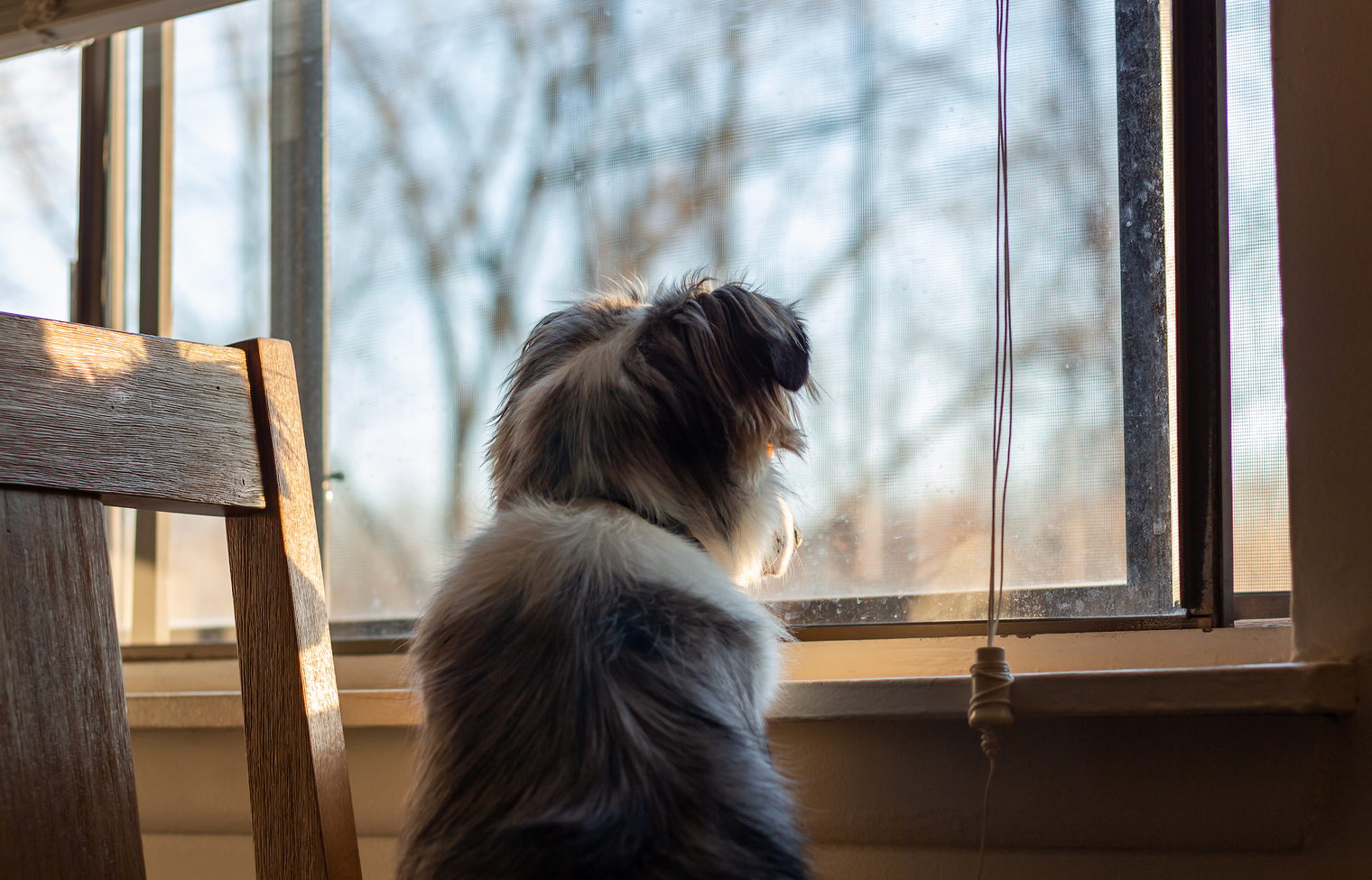Learn how to recognise the symptoms of anxiety in dogs and explore effective treatments for separation anxiety, including solutions for severe cases. Help your dog feel calmer and more secure at home.
Dogs with separation anxiety in Hong Kong face unique challenges. Cramped living spaces, high-rise living with limited outdoor access, and the fast-paced lifestyle of their owners create a perfect storm for anxiety.
In this guide, I'll share proven techniques that work specifically for Hong Kong's urban pet owners. No generic advice - just practical solutions that account for our city's unique living conditions and lifestyle demands.

Let's help your dog find peace when you're not home.
Hong Kong Dog Separation Anxiety Statistics
Studies suggest that a significant portion of dogs, ranging from 15% to 40%, may experience separation anxiety.
Hong Kong Specific: published 1991
One article from the South China Morning Post estimates that around 15-20% of dogs in Hong Kong may have separation anxiety, which translates to about 20,000 dogs.
For now, General Dog Population: Hong Kong's dog population was estimated at approximately 304,000 in 2023. It will be about at least 60,800 dogs that have separation anxiety.
What Are The Symptoms of Dog’s Separation Anxiety?
Dogs communicate their distress in various ways. Recognizing these signs early allows you to address the problem before it becomes severe. Pay close attention to your dog's behavior when you prepare to leave and when you're gone.
Common symptoms of separation anxiety include:
-
Excessive barking, howling, or whining that starts when you prepare to leave
-
Destructive behavior (chewing furniture, scratching doors) only when alone
-
Pacing in patterns when you're getting ready to leave
-
Excessive drooling or panting not related to heat or exercise
-
House soiling despite being fully house-trained
-
Escape attempts that may result in self-injury
-
Loss of appetite when left alone
How To Prevent Dog Stress in Hong Kong
Living in crowded urban areas like Hong Kong presents special challenges for dog owners dealing with canine stress. The constant noise, limited space, and busy schedules can all contribute to heightened anxiety in dogs. This section explores advanced techniques for managing these urban-specific stressors, helping your dog thrive despite city living constraints.
Additional Exercises for Reducing Stress
Physical and mental activity are powerful tools for managing canine stress. A tired dog is generally a calmer dog. In urban environments, being strategic about exercise becomes especially important due to space limitations and the need to work around busy schedules.
Dogs need regular physical outlets to manage their stress levels. According to recent research, urban dogs tend to be more anxious than their rural counterparts, with dogs in the most urban settings showing fearfulness scores approximately 70% higher than those in rural areas. This highlights why city dogs need careful attention to their exercise needs.
Mental Stimulation Activities for Urban Dogs
Beyond physical exercise, mental stimulation is crucial for stress reduction:
1. Teach new commands or tricks weekly (5-10 minutes daily)
2. Use snuffle mats or scatter feeding to engage natural foraging instincts
3. Practice nose work by hiding treats around your home
4. Set up indoor obstacle courses with household items
5. Incorporate training games into daily routines
Creating a Safe Environment
A properly prepared environment can significantly reduce your dog's anxiety. The goal is to create a space that feels secure and comforting even in your absence.
Follow these steps to create an ideal safe space:
1. Choose the right location: Select a quiet area of your home where your dog naturally feels comfortable. This might be a specific room or a sectioned-off area.
2. Add proper containment: If using a crate, ensure it's large enough for your dog to stand, turn around, and lie down comfortably. For dogs who dislike crates, consider a dog-proofed room with a baby gate.
3. Provide proper temperature control: Ensure the area isn't too hot or cold. Hong Kong's humidity can be challenging, so consider a fan or air conditioning if needed.
4. Reduce external stimuli: Minimize visual triggers by positioning the space away from windows with heavy street traffic or using curtains to block outside views that might cause barking.
5. Create ambient sound: Leave on a television, radio, or white noise machine to mask outside sounds that might trigger anxiety.
6. Ensure proper lighting: Some dogs prefer dim lighting, while others feel more secure with lights on. Experiment to see what works best.
Using Familiar Items and Scents
Familiar items provide comfort and security when you're away:
1. Clothing with your scent: Place a recently worn (unwashed) t-shirt or blanket in your dog's area. Your scent provides reassurance.
2. Bedding and toys: Include your dog's favorite bed and toys that they associate with security and comfort.
3. Consider calming aids: Pheromone diffusers like Adaptil release calming dog-appeasing pheromones. Calming treats containing ingredients like L-theanine or chamomile may help some dogs.
4. Puzzle toys with food: Fill Kong toys or other puzzle feeders with treats that take time to extract. This redirects focus and creates positive associations with alone time.
5. Consistency in placement: Keep items in the same location to create a predictable environment that reduces uncertainty.
The prevalence of dog separation anxiety has increased dramatically, with one survey reporting a 760% increase in observed anxious behaviors between 2020 and 2022. Creating a secure environment is the foundation for addressing this growing problem.
🐾 Top Supplements for Dog’s Separation Anxiety
1. Pawsitive Powder – Calming & Stress Support Powder
A gentle herbal blend featuring Reishi mushroom and ginseng, known for their calming effects on the nervous system. Ideal for dogs experiencing anxiety from being alone, loud noises, or travel.
Key Benefits:
-
Supports emotional balance and reduces hyperactivity.
-
Promotes relaxation without drowsiness.
2. Pawsitive Calm – Calming & Stress Relief Capsules
A convenient capsule form of the Pawsitive Calm formula, perfect for on-the-go support or picky eaters. Provides the same stress-relieving benefits in an easy-to-administer capsule.
Key Benefits:
-
Helps manage separation anxiety and environmental stress.
-
Supports a calm demeanor during stressful situations.
3. ImmunoPro – Natural Support for Immune and Digestive Well-Being
While primarily designed to support immune and digestive health, ImmunoPro also aids in promoting emotional balance, making it beneficial for dogs with anxiety-related digestive issues.
Key Benefits:
-
Supports overall well-being and resilience.
-
Helps maintain a healthy gut, which can influence mood and behavior.
🌿 Why Choose LitPet's TCM Supplements?
Natural Ingredients: Formulated with time-tested herbs like Reishi and valerian root to gently calm the nervous system.
-
Holistic Approach: Addresses the root causes of anxiety, not just the symptoms.
-
Made in Hong Kong: Locally produced with quality and safety in mind.
For pet owners in Hong Kong seeking natural solutions for their dog's separation anxiety, LitPet's TCM-based supplements offer a gentle and effective approach to promoting emotional well-being
How To Treat Your Dog’s Separation Anxiety Yourself?
Desensitization is the most effective long-term solution for separation anxiety. This involves systematically exposing your dog to increasingly longer periods alone while keeping them below their anxiety threshold.
Step-by-Step Desensitization Process
1. Identify departure cues: Dogs learn to associate certain actions with your leaving, such as picking up keys or putting on shoes. Make a list of your typical pre-departure routines.
2. Desensitize departure cues: Perform these actions randomly throughout the day without actually leaving. Pick up your keys, then sit on the couch. Put on your coat, then prepare dinner. This breaks the association between these cues and your departure.
3. Practice brief separations: Start with extremely short absences - even just stepping outside for a few seconds while your dog remains calm.
4. Use a clear signal: Develop a specific phrase or gesture that indicates "I'll be back," which you use consistently before leaving.
5. Gradually increase duration: Slowly extend your absence in small increments:
-
Start with 1-2 minutes
-
Progress to 5 minutes
-
Move to 10 minutes
-
Continue to 20 minutes
-
Extend to 30 minutes
-
Work up to 1 hour and beyond
6. Return calmly: When you come back, keep greetings low-key. Excessive excitement at your return can unintentionally heighten the contrast between your presence and absence.
Dog-Friendly Locations in Hong Kong
Hong Kong offers several excellent locations for dog exercise despite being a dense urban environment:
1. Central and Western District Promenade - This waterfront area provides open spaces for walking and limited play.
2. Cyberport Waterfront Park - Features dedicated dog areas and water views.
3. Bowen Road Fitness Trail - A flat, paved walking path that's perfect for dog walking.
4. Wan Chai Waterfront - Less crowded during weekday mornings.
5. West Kowloon Cultural District - Has designated pet zones with harbor views.
When visiting these locations, always bring:
-
Waste bags
-
Portable water bowl
-
Leash appropriate for the area
-
Treats for positive reinforcement
-
A familiar toy for comfort
For optimal stress reduction, try visiting these locations during off-peak hours (weekday mornings or late evenings) when they're less crowded and overwhelming for anxious dogs.
Conclusion
Helping your dog with separation anxiety in Hong Kong takes patience, but it's worth the effort. By identifying the early signs and creating a safe space with familiar items, you've taken the first steps toward a calmer pet. The gradual training approaches we've covered - from desensitization to professional training options available in Hong Kong - build a foundation for lasting change.

